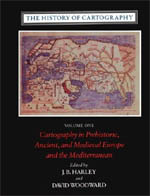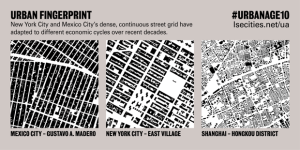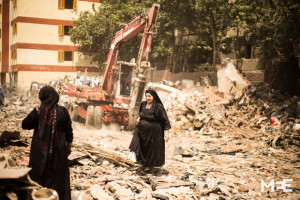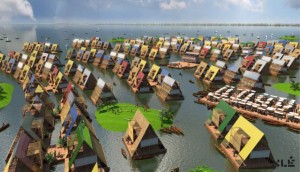The University of Chicago Press ~ The History Of Cartography
 The first volume of the History of Cartography was published in 1987 and the three books that constitute Volume Two appeared over the following eleven years. In 1987 the worldwide web did not exist, and since 1998 book publishing has gone through a revolution in the production and dissemination of work. Although the large format and high quality image reproduction of the printed books (see right column) are still well-suited to the requirements for the publishing of maps, the online availability of material is a boon to scholars and map enthusiasts.
The first volume of the History of Cartography was published in 1987 and the three books that constitute Volume Two appeared over the following eleven years. In 1987 the worldwide web did not exist, and since 1998 book publishing has gone through a revolution in the production and dissemination of work. Although the large format and high quality image reproduction of the printed books (see right column) are still well-suited to the requirements for the publishing of maps, the online availability of material is a boon to scholars and map enthusiasts.
On this site the University of Chicago Press is pleased to present the first three volumes of the History of Cartography in PDF format. Navigate to the PDFs from the left column. Each chapter of each book is a single PDF. The search box on the left allows searching across the content of all the PDFs that make up the first six books.
“An important scholarly enterprise, the History of Cartography … is the most ambitious overview of map making ever undertaken …. People come to know the world the way they come to map it—through their perceptions of how its elements are connected and of how they should move among them. This is precisely what the series is attempting by situating the map at the heart of cultural life and revealing its relationship to society, science, and religion…. It is trying to define a new set of relationships between maps and the physical world that involve more than geometric correspondence. It is in essence a new map of human attempts to chart the world.”—Edward Rothstein, New York Times
“It is permitted to few scholars both to extend the boundaries of their field of study and to redefine it as a discipline. Yet that is precisely what The History as a whole is doing.”—Paul Wheatley, Imago Mundi
“A major scholarly publishing achievement.… We will learn much not only about maps, but about how and why and with what consequences civilizations have apprehended, expanded, and utilized the potential of maps.”—Josef W. Konvitz, Isis
Go to: http://www.press.uchicago.edu/books/HOC/index.html
Sibusiso Tshabalala ~ This Nigerian Architect Wants To Turn Africa’s Water Slums Into Floating Cities
Nigerian architect Kunlè Adeyemi is re-imagining African’s water slums as floating islands.
Nearly 70% of Africa’s capital cities—like Lagos, Luanda and Kinshasa—are near water, with many urban dwellers living in bungalows, wooden structures and shacks on water. But rising sea levels, increasing rainfall and climate change threaten many of these structures, leaving water slum residents vulnerable to flooding.
Read more: http://qz.com/this-nigerian-architect-wants-to-turn-africas-water-slums-into-floating-cities/
Linda Poon ~ Mapping The ‘Urban Fingerprints’ Of Cities
 Like humans, cities and neighborhoods have their own unique fingerprints. While genes determine ours, a city’s mark is characterized by the relationship between buildings and open spaces. Think of it as “spatial DNA,” which is typically mapped out by urban designers and researchers in black-and-white diagrams. Black shapes indicate buildings and white represent the open ground.
Like humans, cities and neighborhoods have their own unique fingerprints. While genes determine ours, a city’s mark is characterized by the relationship between buildings and open spaces. Think of it as “spatial DNA,” which is typically mapped out by urban designers and researchers in black-and-white diagrams. Black shapes indicate buildings and white represent the open ground.
“These are useful tools to [visualize] the micro-scale of urban [neighborhoods] and understand how buildings and their surroundings succeed or fail in making a continuous and integrated urban whole,” Peter Griffiths, editorial officer of the Cities Research Center at London School of Economics and Political Science, says in an email. The maps were created by researchers at the center’s Urban Age program, who have been studying how the layout of rapidly urbanizing cities can affect their livability. Researchers used satellite photography and official city data to create the maps.
Read more: http://www.citylab.com/housing/mapping-the-urban-fingerprints
Mariam Musa ~ Life In The Slums Of Cairo

Om Baraka, a 55-year-old inhabitant of the Sudan Nest slum, gathers wooden fragments of the ruins of her house on 26 August 2015, after a police raid was carried out to forcibly evict residents of the area (MEE/Mariam Musa)
Last Tuesday, police forces raided the Sudan Nest, a slum near al-Dokki neighbourhood in Cairo.
Police forcibly evacuated the inhabitants of the slum from their shoddy dwellings, using bulldozers to destroy houses in front of residents’ own eyes. When angry inhabitants tried to stop the demolitions and fight back, police shot tear gas and dispersed them.
“At least those who are in prison know that their suffering will end one day,” said Om Baraka, a 55-year-old resident of the Sudan Nest slum. “They dream of a better life in their homes among their families.”
“People who live here are in a bigger prison, as they don’t even dare to dream of a better future,” she continued as she stood on the ruins of what was her home after being forcibly evicted by police forces.
See more at: http://www.middleeasteye.net/cairo-part-world-slums
- Page 2 of 2
- previous page
- 1
- 2



